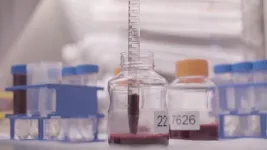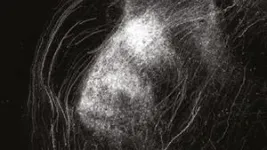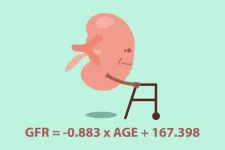(Press-News.org) By Rachel Tompa, Ph.D
Your blood is a delicate mixture. Researchers and clinicians often use blood to learn what’s going on inside our bodies, in part because siphoning off a tube of blood is easier and less painful than taking biopsies of an internal organ.
But in some cases, it turns out that blood can be very different outside our bodies. When it comes to certain emerging research techniques, the clock starts ticking as soon as your blood hits the tube. As little as six to eight hours later, some aspects of your blood’s molecular composition will have changed to the point that the experiment would give completely different results.
If a patient or research study volunteer is having a blood draw at or near a research facility that can perform this type of experiment on-site, that time delay doesn’t come into play. But for research studies or clinical trials that hope to enroll patients and volunteers in rural areas or draw blood at clinics without an attached high-tech laboratory, rushing the blood samples to the processing site becomes a problem. Most clinical sample collection occurs near major research hubs, limiting our understanding of underserved and socio-economically deprived communities.
A new approach, called CryoSCAPE, developed by researchers at the Allen Institute for Immunology, a division of the Allen Institute, aims to stop that clock, lower experiment costs to broaden the reach and utility of these cutting-edge technologies for blood draws. The method uses a simple chemical mixture, pre-packaged in a small tube, to put blood into a type of “suspended animation,” protecting it from damage during freezing and preserving these delicate molecules in their natural state.
This new scalable immune profiling technology is described in a recently published study in the Journal of Translational Medicine.
“Virtually all clinical trials run by biopharmaceutical companies will collect blood at one site, but then they have to ship the blood overnight to a centralized processing site,” said Peter Skene, Ph.D., director of high resolution translational immunology at the Allen Institute for Immunology, who is one of the developers of the new approach. “We wanted to solve this problem by developing a methodology that allows immediate blood stabilization at the bedside.”
The approach aims to broaden the reach of a class of experiments known as single-cell technologies, which capture the exact molecular composition of thousands or more of a patient’s individual cells, one cell at a time. As these single-cell methods increase in use in the research world and ultimately make their way to clinical use, a blood stabilization technique like this could help increase the accuracy of experimental results and bring single-cell methods to research in diverse human populations.
“This technique allows you to, in a way, keep the sample at the stage it was when the patient first gave blood,” said Lisa Forbes Satter, M.D., an immunologist and pediatrician at Baylor College of Medicine and Texas Children’s Hospital who collaborates with researchers at the Allen Institute to study rare immune-deficiency disorders. “It would be a game changer for institutions and clinics that don’t have a lot of resources.”
The most common of the emerging single-cell technologies is known as single-cell RNA sequencing, a technique that reads out the genes switched on or off in a cell by capturing information about each individual cell’s full suite of RNA molecules. RNA is particularly finicky — the Allen Institute team found that just six hours after blood collection, RNA sequencing data are completely different from those in cells analyzed right after a blood draw. But the new way of stabilizing blood could be useful for other applications too, its creators say, because it keeps the cells alive and close to their natural state in the body.
The Allen Institute team’s approach also scales up the single-cell experiments, to the point that they can now process hundreds of blood samples at once. The technology could be used to broaden the reach of immunology studies at the Allen Institute and elsewhere, Skene said. The method would lower the barriers to participating in research studies because blood could be drawn at neighborhood clinics or pop-up sites, eliminating the need for volunteers to travel to a research laboratory. Skene and his colleagues hope these lowered barriers could lead to increased enrollment of members of underserved communities in research studies and clinical trials. The team also plans to use the approach to help streamline and expand clinical trials conducted by biopharmaceutical companies, those that typically need to ship blood samples to a centralized lab for analysis.
“As a team, we’ve developed a lot of exciting but complicated new approaches, but we also need to make these approaches accessible,” said Julian Reading, senior manager of flow cytometry at the Allen Institute for Immunology. “Now we’re working to open access to this technology, to get to a point where we can actually have broader impact.”
About the Allen Institute
The Allen Institute is an independent, 501(c)(3) nonprofit research organization founded by philanthropist and visionary, the late Paul G. Allen. The Allen Institute is dedicated to answering some of the biggest questions in bioscience and accelerating research worldwide. The Institute is a recognized leader in large-scale research with a commitment to an open science model. Its research institutes and programs include the Allen Institute for Brain Science, the Allen Institute for Cell Science, the Allen Institute for Immunology, and the Allen Institute for Neural Dynamics. In 2016, the Allen Institute expanded its reach with the launch of The Paul G. Allen Frontiers Group, which identifies pioneers with new ideas to expand the boundaries of knowledge and make the world better. For more information, visit alleninstitute.org.
# # #
Media Contact
Peter Kim, Sr. Manager, Media Relations
206-605-9884 | peter.kim@alleninstitute.org
END
VANCOUVER, Wash. – Some of the most productive apple regions in America are facing big challenges from a changing climate, according to a Washington State University study.
Researchers analyzed over 40 years of climate conditions that impact the growth cycle of apple trees from bud break and flowering through fruit development, maturation and color development.
While many growing areas are facing increased climate risks, the top three largest apple producing counties in the U.S. were among the most impacted: Yakima in Washington, Kent in Michigan and Wayne ...
An up-close look at how patients respond to the drug at different times and doses adds nuance to a recent finding that Paxlovid does not work for long Covid.
An extended course of Paxlovid appears to help some patients with long Covid, according to a case series by UC San Francisco researchers that suggests this treatment option holds promise for some of those struggling with debilitating symptoms.
These results are at odds with recent research that has failed to show the antiviral can alleviate persistent symptoms of the disease. The authors said more study is needed to find out which patients may benefit from the drug and how long it should be given.
The ...
From photographs of decimated buildings to military and civilian casualty counts to narratives of suffering, news media bring information about foreign conflicts to American audiences. But does this coverage actually affect public opinion about whether and how the United States should be involved in a conflict? Does it influence what Americans think about the U.S. providing military, diplomatic, and economic aid to foreign nations?
A new paper from researchers at the Annenberg Public Policy Center (APPC) of the University of Pennsylvania examines these questions and finds that media coverage of civilian casualties increases public support for U.S. involvement in conflicts by evoking empathy ...
In the Arctic, the old, multiyear ice is increasingly melting, dramatically reducing the frequency and size of pressure ridges. These ridges are created when ice floes press against each other and become stacked, and are a characteristic feature of Arctic sea ice, an obstacle for shipping, but also an essential component of the ecosystem. In a recently released study in the journal Nature Climate Change, experts from the Alfred Wegener Institute report on this trend and analyse observational data from three decades of aerial surveys.
Satellite data from the last three decades documents the dramatic changes in Arctic sea ice due to climate change: the area covered in ice in summer ...
Annual health checkups regularly include urine tests that serve several purposes, including checking for symptoms of kidney disease. The presence of albumin in the urine is one indicator as is glomerular filtration rate. In diabetic nephropathy, albuminuria first appears, leading to excessive filtration and eventually a decrease in GFR.
In the elderly, however, excessive filtration cannot be detected due to age-related GFR decline. To accurately assess GFR, Osaka Metropolitan University researchers have come up with ...
A new set of guidelines has been developed to assist with the diagnosis and expert management of serious blood cancers in pregnancy.
About 12.5 pregnancies per 100,000 are affected by blood cancers such as acute leukaemia and aggressive lymphomas, and their incidence has been rising.
Between 1994 and 2013, they increased by 2.7 per cent a year, due to factors including women having children later, improved diagnostic techniques, and increased health system engagement.
An Australian working group has now published a new position statement in the latest edition of The Lancet Haematology, based on current evidence and expert consensus.
It ...
Biologists at Indiana University Bloomington have shown that the surfaces of plant leaves are coated with a diverse array of RNA molecules. The finding suggests that the RNA present on the leaf surface may play a role in shaping the microbial communities that inhabit them, potentially influencing plant health and interactions within their environment, according to a new study.
The study, Diverse plant RNAs coat Arabidopsis leaves and are distinct from apoplastic RNAs, was published Jan. 3, 2025 in the Proceedings of the National Academy of Sciences. The first authors are Lucía ...
Urban sprawl is not just unsightly. It could also be impeding intergenerational mobility for low-income residents and reinforcing racial inequality, according to a series of recent studies led by a University of Utah geographer.
One analysis of tract-level Census data co-authored with a former economics graduate student in the U’s College of Social & Behavioral Science found that people who grew up in high-sprawl neighborhoods have less earning potential than those who grew in denser neighborhoods.
“For adults, jobs are harder to access in more sprawling neighborhoods,” said Kelsey Carlston, now an assistant professor of economics at Gonzaga University. “If we ...
Raymond Y. Huang, MD, Ph.D., of the Department of Radiology at Brigham and Women’s Hospital, is the corresponding author of a paper published in the Journal of Clinical Oncology, “Comparative Analysis of Intracranial Response Assessment Criteria in Patients With Melanoma Brain Metastases Treated With Combination Nivolumab + Ipilimumab in CheckMate 204.”
How would you summarize your study for a lay audience?
Our study examines how different imaging criteria can be used to assess brain tumor responses ...
Go faster, farther, more efficiently.
That’s the goal driving spacecraft propulsion engineers like Chen Cui, a new assistant professor at the University of Virginia School of Engineering and Applied Science. Cui is exploring ways to improve electric propulsion thrusters — a key technology for future space missions.
“In order to ensure the technology remains viable for long-term missions, we need to optimize EP integration with spacecraft systems,” Cui said.
Working with his former adviser, University of Southern California professor Joseph Wang, ...





